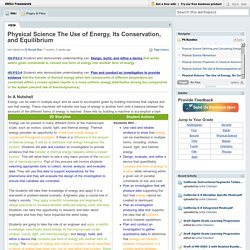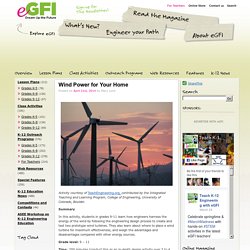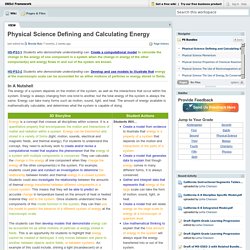

Working with Wind Energy. Positive Physics - Physics problems and curriculum for learners on any level! Physical Science The Use of Energy, Its Conservation, and Equilibrium. HS-PS3-3 Students who demonstrate understanding can: Design, build, and refine a device that works within given constraints to convert one form of energy into another form of energy.

HS-PS3-4 Students who demonstrate understanding can: Plan and conduct an investigation to provide evidence that the transfer of thermal energy when two components of different temperature are combined within a closed system results in a more uniform energy distribution among the components in the system (second law of thermodynamics). Energy can be seen in multiple ways and be used to accomplish goals by building machines that capture and use that energy.
These machines will transfer one type of energy to another form until a balance between the amounts of the different forms of energy is reached. Show this by building a machine to accomplish a task. Introduction to the OKSci Framework Return to Physical Science Introduction. Wind Power for Your Home. Activity courtesy of TeachEngineering.org, contributed by the Integrated Teaching and Learning Program, College of Engineering, University of Colorado, Boulder.

Summary In this activity, students in grades 9-11 learn how engineers harness the energy of the wind by following the engineering design process to create and test two prototype wind turbines. They also learn about where to place a wind turbine for maximum effectiveness, and weigh the advantages and disadvantages compared with other energy sources. Grade level: 9 – 11 Time: 200 minutes (conduct this as an in-depth design activity over 3 to 4 class periods) Cost: $3 per group Engineering Connection. NILS FERBER. Dissecting a Spring powered Motor for a Pull Back Toy Spring2014 v1.
Link overview rollercoasters. Link overview carramp. Middle School Physical Science. Balloons & Buoyancy - Gas, Thermodynamics, Pressure. PS05. PS05. Multimedia: Heat, Temperature, and Conduction. Keeley Harmon CERFramework. Sc1107 26. Energy Unit Notes. HOW IS THE KINETIC ENERGY OF A BODY AFFECTED BY ITS MASS AND VELOCITY.docx. 05 Manual Energy - Heck's Physics. DO SPEED AND MASS AFFECT KINETIC ENERGY.docx. CAN HEAT ENERGY MAKE THINGS MOVE.docx. HOW DO WEIGHT AND HEIGHT AFFECT GRAVITATIONAL POTENTIAL ENERGY.docx. HOW IS WORK MEASURED.docx. WHAT MAKES IT MOVE. HEAT ENERGY SMORGASBORD.docx. Fire-Resistant Water Balloon. Blow up a balloon just as you normally would and tie it off.

Light a candle and place it in the middle of the table. Put on your safety glasses because it's time to pop the balloon. Hold the balloon a foot or two over the top of the flame and slowly move the balloon closer and closer to the flame until it pops. You'll notice that the flame doesn't have to even touch the balloon before the heat melts the latex and it pops. Let's just say you had to prove what you already know. Let's repeat the experiment but this time the bottom of the balloon will have a layer of water inside. Fill the balloon to the top with water – it probably holds a few ounces (60 mL for the scientists) – and then blow it up with air.
Take It Further! Now that you know water will prevent a balloon from popping, try other liquids. Water is a great substance for soaking up heat. Using water to control heat is a valuable process. Energy packet. Google Docs - create and edit documents online, for free. Google Docs - create and edit documents online, for free. Google Docs - create and edit documents online, for free. Lesson Plans & Resources - Nuclear Science Week. 05 Manual Energy - Heck's Physics.
> Energy & Machines Activities and Games Free Downloads. Homeschool-freedownloads Physical Science Sorry this category is so small.

I don’t often get stuck in situations where I have to generate physical science resources. (My inventions always come about as the result of finding myself in a teaching situation for which I can’t find adequate resources.) Physics labs I’ve written: Click here to see a listing of available labs (free downloads) Energy “The Case of the Missing Joules” For ages 9-14. Machines. Energy Foundations for High School Chemistry. Defining and Calculating Energy curriculum guide. Physical Science Defining and Calculating Energy. HS-PS3-1 Students who demonstrate understanding can: Create a computational model to calculate the change in the energy of one component in a system when the change in energy of the other component(s) and energy flows in and out of the system are known.

HS-PS3-2 Students who demonstrate understanding can: Develop and use models to illustrate that energy at the macroscopic scale can be accounted for as either motions of particles or energy stored in fields. The energy of a system depends on the motion of the system, as well as the interactions that occur within the system. Energy is always changing from one kind to another, but the total energy of the system is always the same. Energy can take many forms such as motion, sound, light, and heat. The amount of energy available is mathematically calculable, and determines what the system is capable of doing. Introduction to the OKSci Framework Return to Physical Science Introduction Return to Physical Science Bundles.
Renewable and nonrenewable energy. Environmental Literacy & Inquiry. STEM. Energy (Part 1) - Next Generation Science Standards. 4.Energy (Part 2) - Next Generation Science Standards. Solar Dynamics Observatory. Elementary School Science Literacy Program What is it?

Think Scientifically is a three-book series for elementary school teachers that integrates math, science and reading instruction. Each storybook focuses on a key science theme and includes a hands-on science lesson, math and language arts activities, and other educational resources that can be easily utilized in the classroom. The books are based on national standards and were written by teachers. Why is it important? With increasing pressure on schools to focus on math and reading, science often gets left behind. What are the books about? The Day Joshua Jumped Too Much Joshua discovers that the Sun is Earth's primary source of energy and learns what the world would be like without it!
What activities can I find in the books? The books include a hands-on lab activity, a data collection/graphing activity, a language arts activity, a book walk, a bulletin board idea, etc. Where can I find the books? Fourth Grade Converting Energy. 4-PS3-2 Students who demonstrate understanding can: Make observations to provide evidence that energy can be transferred from place to place by sound, light, heat, and electric currents. 4-PS3-4 Students who demonstrate understanding can: Apply scientific ideas to design, test, and refine a device that converts energy from one form to another. 4-PS4-1 Students who demonstrate understanding can: Develop a model of waves to describe patterns in terms of amplitude and wavelength and to show that waves can cause objects to move.

Energy can be observed in a variety of situations (motion of objects, transfer of sound, light, heat, electric currents, and motion of waves).